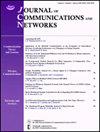权力受限的调度器和对手之间的信息博弈时代
IF 3.2
3区 计算机科学
Q2 COMPUTER SCIENCE, INFORMATION SYSTEMS
引用次数: 0
摘要
我们考虑一个时隙通信网络,它由一个基站(BS)、一个对手、Ν用户和n个通信通道组成。在本文的第一部分中,我们考虑了在Ν用户之间异构划分n个通信通道的设置。BS在通信通道n的子集上向第5个用户发送更新,其中n,i∩n,j不一定是空集。在每个时隙,BS通过通信信道向用户发送更新报文,攻击者通过阻断通信信道来阻断BS发送的更新报文。攻击方有η个离散发射功率级与用户通信,攻击方有m个离散阻断功率级阻断通信信道。更新包成功传输的概率取决于这些功率级别。攻击方和对手分别具有传输和阻塞平均功率约束。我们为这种通信网络的平均信息年龄提供了一个通用的下界。证明了具有任意可行的传输功率选择策略的统一用户选择策略、统一通信信道选择策略是最优的;对于最大用户选择策略,任意可行的传输功率选择策略下的统一通信信道选择策略是2最优的。在论文的第二部分中,我们考虑了这样一种设置,即BS选择一个传输策略,对手从随机平稳策略集合中选择一个阻塞策略,并且n,i = n,即所有用户都可以在所有信道上接收更新。我们证明了这种通信网络可能存在纳什均衡,也可能不存在纳什均衡,并确定了纳什均衡总是存在的特殊情况。本文章由计算机程序翻译,如有差异,请以英文原文为准。
Age of information games between power constrained schedulers and adversaries
We consider a time slotted communication network consisting of a base station (BS), an adversary, Ν users and N
s
communication channels. In the first part of the paper, we consider the setting where N
s
communication channels N
s
are heterogeneously divided among Ν users. The BS transmits an update to the ¿th user on a subset of the communication channels N
s,i
where N
s,i
∩ N
s,j
is not necessarily an empty set. At each time slot, the BS transmits an update packet to a user through a communication channel and the adversary aims to block the update packet sent by the BS by blocking a communication channel. The BS has η discrete transmission power levels to communicate with the users and the adversary has m discrete blocking power levels to block the communication channels. The probability of successful transmission of an update packet depends on these power levels. The BS and the adversary have a transmission and blocking average power constraint, respectively. We provide a universal lower bound for the average age of information for this communication network. We prove that the uniform user choosing policy, the uniform communication channel choosing policy with any arbitrary feasible transmission power choosing policy is 4 optimal; and the max-age user choosing policy, the uniform communication channel choosing policy with any arbitrary feasible transmission power choosing policy is 2 optimal. In the second part of the paper, we consider the setting where the BS chooses a transmission policy and the adversary chooses a blocking policy from the set of randomized stationary policies and N
s,i
= N
s
for all i, i.e., all users can receive updates on all channels. We show that a Nash equilibrium may or may not exist for this communication network, and identify special cases where a Nash equilibrium always exists.
求助全文
通过发布文献求助,成功后即可免费获取论文全文。
去求助
来源期刊
CiteScore
6.60
自引率
5.60%
发文量
66
审稿时长
14.4 months
期刊介绍:
The JOURNAL OF COMMUNICATIONS AND NETWORKS is published six times per year, and is committed to publishing high-quality papers that advance the state-of-the-art and practical applications of communications and information networks. Theoretical research contributions presenting new techniques, concepts, or analyses, applied contributions reporting on experiences and experiments, and tutorial expositions of permanent reference value are welcome. The subjects covered by this journal include all topics in communication theory and techniques, communication systems, and information networks. COMMUNICATION THEORY AND SYSTEMS WIRELESS COMMUNICATIONS NETWORKS AND SERVICES.

 求助内容:
求助内容: 应助结果提醒方式:
应助结果提醒方式:


